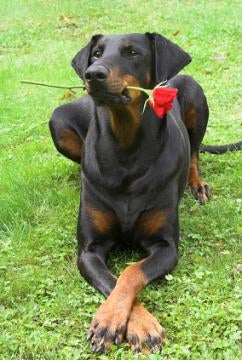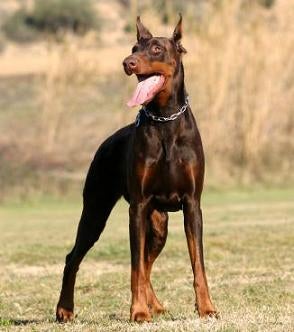Doberman Pinscher Puppy Information & Training
The razor sharp snout and the rigid ears of the Doberman Pinscher are unmistakable. This noble breed, which originated in Germany, has had its share of media attention, and not all of it has been positive.
With the help of Doberman Pinscher lovers around the world the breed is enjoying an image makeover as a dog suited for companionship. If you enjoy an intelligent, challenging breed, read on, a Doberman puppy may just be the right dog breed for you.
 [google_ad:DOTR_CMS_468x60_InArticle1]
[google_ad:DOTR_CMS_468x60_InArticle1]
Doberman Pinscher History
The Doberman breed began in Germany in the 1890s with a tax collector named Karl Friedrich Louis Dobermann. During his trips to collect taxes he ventured along many bandit-infested highways, and needed a way to protect himself. Thus began his search for the perfect security dog.He wanted an animal that was intelligent, loyal, strong, and ferocious. Dobermann also had a second job as a dog impounder, so he had easy access to various types of dogs for breeding. The only documented cross for the breed is the Greyhound, though the Rottweiler, Pinscher, Beauceron, Great Dane, and German Shorthaired Pointer are all thought to have contributed to the Doberman Pinscher's bloodlines. After Dobermann's death the breed was fondly named after him. Otto Goeller and Philip Gruening continued to work on the breed, shaping it into the dog we know and love today.
Doberman Pinscher Appearance
The Doberman Pinscher is a medium sized dog reaching from 26 to 28 inches in height and 75 to 100 pounds. The female is typically smaller and a bit more slender than the male dog. The breed standard calls for a deep, broad chest and powerful muscles as the Doberman was intended to be a working dog. Lately, however, many Doberman breeders have been showing a more slender animal, and the look is starting to gain popularity. Most owners still desire the stockier Doberman though, as many of the dogs are used for protection.Most Doberman Pinschers are of the black and tan variety. The majority of the body is black, with tan markings around the face and legs. However, there is a color dilution gene in the breed that allows for a few other color variations as well. When the dog has a dominant color and a dominant dilution gene the result is a brown and rust dog, which is the most common variation of the black and tan coloring.
The remaining two colors, blue and fawn, both involve the occurrence of recessive genes. The blue color is a diluted black, while the fawn (also the rarest color) is a diluted red. The last two colors are actually not recognized by some official organizations and thus are not shown internationally. In addition to these normal colors a white Doberman was born in 1976 and was subsequently inbred in order to carry on the mutation. The white Dobermans have shown significant behavioral problems however, and it has been recommended that no one breed the white variety any more.
Most of the Dobermans seen in North America have had their tails docked and their ears cropped. The dog in its natural form has thin, long tail, and medium length floppy ears. The tail has been cropped traditionally to avoid breakages that can sometimes happen to working dogs. The cropping of the ears was also done with function in mind, in order to enhance the dog's hearing. In many countries however, these practices are now illegal because they are thought to be cruel to the animal. Thus, many dog shows allow Doberman Pinschers to be shown both with cropped tail and docked ears, or naturally. In Germany however, the dog's country of origin, the breed is only allowed to be shown naturally. In the case of international events this ban is lifted, but the Germans take immense pride in this dog which sprang from their land - and rightly so.
Doberman Puppy Temperament
The temperament of the Doberman Pinscher is a point of contention. The dogs can be sweet, loyal, and wonderful companions to their families. They are also a guard dog however, and have been used for protection and other aggressive duties for hundreds of years. The public image of the Doberman is of a rather vicious dog, and this stereotype prevents many renters and even some homeowners from ever being able to consider the dog as a pet. Both police and military utilize the dog because of its intelligence, loyalty, and physical ability to neutralize aggressors. The dog also appears fierce and sharp physically, especially when the ears are cropped and the tail is docked. Many of the dogs were used in World War II, and there is even a memorial to the Doberman's who died during the Battle of Guam in 1944. Because of this image as the guard dog however, many towns include Dobermans in breed specific legislation.If given the right upbringing through proper puppy socialization and training a Doberman can be a fabulous family dog. They get along well with children and other pets, even including cats. The only time they encounter problems with people is when they perceive a threat to the family. If any family members are threatened than the dog is likely to attack. In fact, statistically speaking, Doberman Pinschers are less likely to attack then other breeds, such as pit-bulls, Rottweilers, and Alaskan Malamutes. Because the dog has been stereotyped as "mean" in media and movies, it gets a bad rap that is not necessarily fully deserved.

Doberman Health Issues
The Doberman was bred to be a healthy working dog, and for the most part it is. Most dogs of the breed live to be about ten years old, with some living much longer than that. Like any purebred dog there are some specific health issues which affect the breed. Feeding a nutritious, well balanced diet and providing adequate exercise to your Dobe will help to prevent many common health problems. As will purchasing your puppy from a reputable, well respected Doberman Pinscher puppy breeder (a Doberman rescue center is also a good option).One of the specific health problems Dobermans have is dilated cardiomyopathy, a condition where the heart becomes enlarged and cannot pump blood as effectively. The disease can be genetic, and can often lead to congestive heart failure. This is one of the reasons why the Doberman Pinscher's lifespan is only ten years. Still, a dog can live for several years with the condition before deteriorating.
Dobermans also suffer from Wobbler disease, or cervical vertebral instability (CVI). It is named such because as the condition worsens the dog begins to have shaky movement, especially in the hind legs. The cause of the wobbling comes from the compression of the spinal cord, which can hinder transmissions from the brain. Symptoms begin with dragging of the hind toes and a slouching of the neck, followed by shaking in the front legs. The disease can be treated with steroids or surgery, but both options provide no guarantee for recovery.
The final major health concern for Dobermans is Von Willebrand disease. This is a genetic blood disorder passed on through recessive genes. The disease hinders coagulation of the blood, making cuts bleed more heavily and bruises appear more easily. Fortunately this disease can be tested for in the parents so as not to pass on the trait. Any good Doberman Pinscher breeder should be willing to share genetic testing information with you, so ask away. If taken care of properly there is no reason why you can't enjoy many happy, long years with your canine companion.
Training Your Doberman Pinscher
As previously mentioned Dobermans are a highly intelligent breed who have been bred to work. Therefore they take to obedience training with great enthusiasm and skill. For a Doberman, obedience training provides much needed mental stimulation, physical exercise and time spent bonding with you. No wonder they love it so much!Dobermans thrive on non violent, reward based training methods. They are highly motivated students who certainly don't require any harsh corrections or intimidation throughout the training process. Many Dobe's have achieved great success with clicker training methods.
Along with plenty of puppy socialization your Doberman should be taught all the basic obedience training commands such as sit, stay, come, down and go to your spot.
Below are some breed specific issues you are well advised to get right when training your Doberman Pinscher puppy:
- Training your Dobe to walk nicely on a loose leash is a big one. Dobermans grow to be big, powerful dogs so it's vital that you have full control of your dog whilst on leash. You'll be spending loads of time out and about with your Doberman puppy so it's highly recommended that you teach proper leash etiquette as soon as possible.
- Just as important as leash training is teaching your Dobe to stop jumping up on you and your guests. Dobermans love to jump up to greet people, but this is obviously an unacceptable behavior for a number of reasons. It's best to teach this to your Doberman puppy early in order to prevent this bad habit from taking hold.
The good news is that the "jumping up" behavior is not all that difficult to prevent or put a stop to. The key is to always be clear and consistent with the message that you are communicating to your Dobe. In other words you must get it through to your dog that jumping up is never acceptable.
- Another urgent Doberman training issue is puppy chewing. Dobe's love to chew when they are young and going through the teething stage. Although this is a natural behavior it is also very annoying and can be expensive! There are some simple strategies you can put into place which will help to redirect and minimize the puppy chewing problems.
If you bring a Doberman puppy into your life please do the right thing by getting along to some obedience training classes or alternatively study and implement the information detailed in Secrets of a Professional Dog Trainer.
Doberman Dog Breed - Summing Up
Though the Doberman Pinscher has gotten a bad rap through media and stereotype, the breed really deserves more consideration. As proof, I'll leave you with a personal experience. One day, as my husband was gardening in the backyard, he felt a hot, slobbery lick on his neck. He wondered how on earth our lab had gotten out when he had just shut him inside. Turning around however, he suddenly found himself face to face with a handsome Doberman Pinscher of glossy coat and generous size.Fear gripped him, these were vicious dogs right? Suddenly, the dog reached forward and licked him from chin to forehead, wagging his tail. That's how we met Boss, our neighborhood sweetheart. He was terrifying indeed, if you fear dog saliva that is. Obviously, not all stereotypes are true. Good luck finding your chosen companion, may the two of you bless each other with much happiness and health for many years to come.
Some other pages you may be interested in:
Discover how to choose your ideal puppy out of a litter.
Puppy crate training the smart and fast way.
Step-by-step puppy house training schedule.
How to choose the perfect dog breed for you and your family.
Please consult the services of a Professional Dog Trainer, Behaviorist or Veterinarian before implementing any of the advice contained on this site.











 Your Privacy Choices
Your Privacy Choices